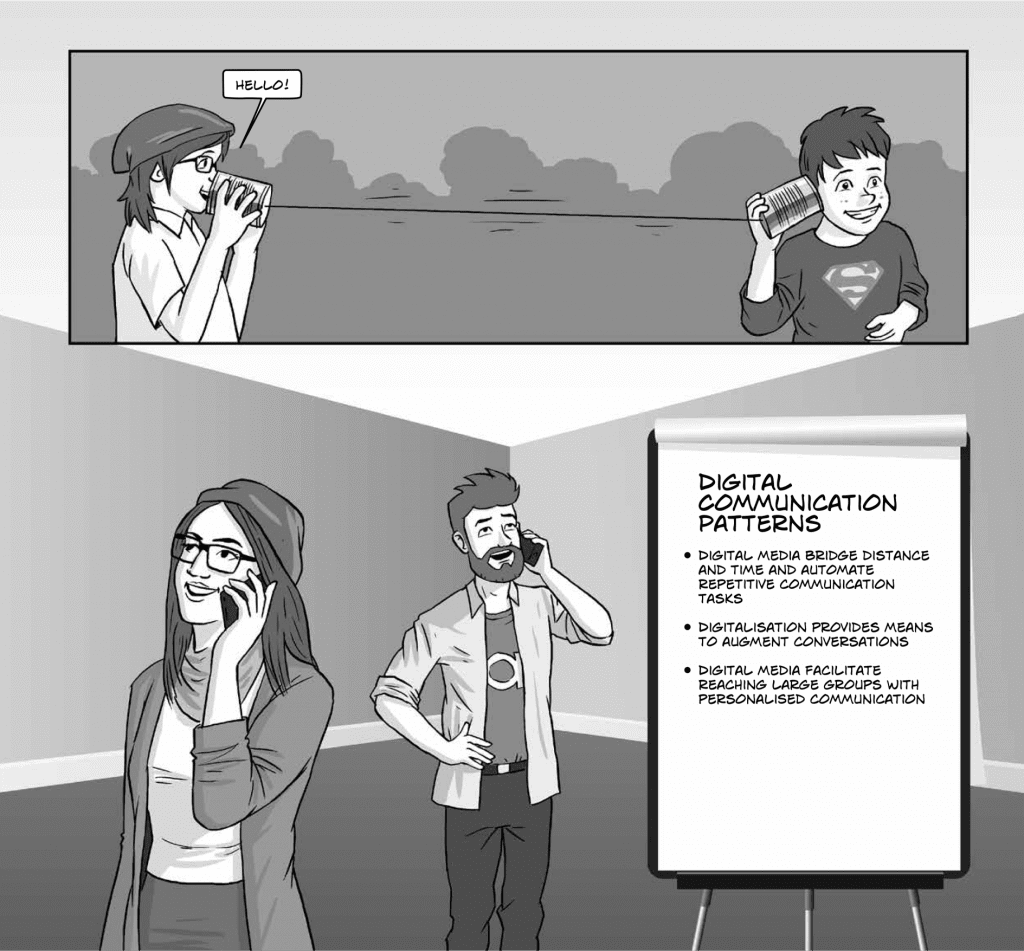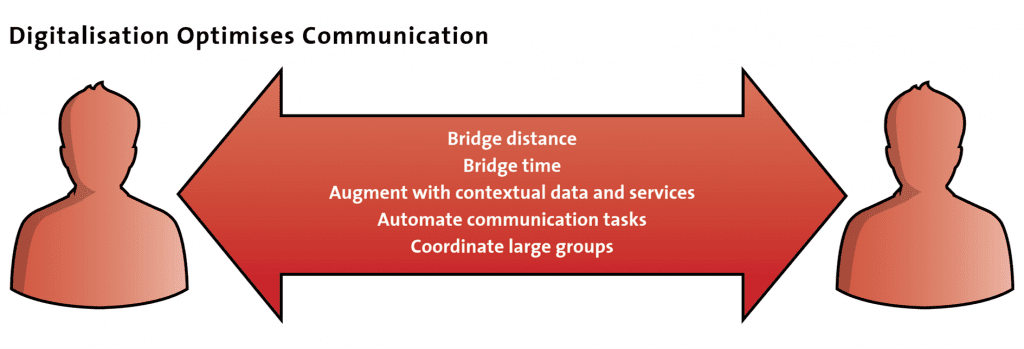Digitalisation aims to optimise communication patterns between humans and their relationship with each other. This goal is realised via digital media, for instance in retrieving and processing information or accessing services. The digital medium takes on the function of overcoming the limitations of natural communication within our private, social and corporate structures. Several means of digital communication have existed for many decades but were often isolated from each other. Only their interplay creates the new essential patterns of communication we interact with and benefit from today.
This section provides examples of the different communication patterns enhancing everyday human communication in business or private lives.
Digital media have the function of bridging distance. Two communicating parties can be located in different places but be part of the same communication process.
Devices for bridging distance are not only the classic telephone or email we use to communicate with family and friends, but also digital chat and video tools such as Skype, FaceTime and other video conferencing platforms. These media add further characteristics to the written and especially the spoken word over distance and generate the feeling of local presence in a conversational partner. This allows misunderstandings due to a lack of face-to-face communication to be effectively reduced.
Digital media not only bridge distance – they also allow for the bridging of time, with instantaneous connectivity on the one hand and the ability to send and retrieve messages with a managed delay on the other.
In the past, it was the in-tray jam-packed with paper that asynchronously organised requests and responses. Electronic workbaskets that were introduced in business environments in the 1980s mitigated the lack of traceability and efficiency of the in-tray. However, digital media now provide unmatched flexibility. With collaboration platforms, email, WhatsApp, and voice and video messaging, the time for engaging in communication can be managed according to one’s individual time constraints. A message can not only be read or listened to the following day, alleviating the pressure of immediate response, but it can also be accessed and re-accessed when needed and responded to with consideration, in detail and to the point. Digital communication bridging time, similar to bridging distance, can support accuracy and quality in both private and business communication.
Communication can be augmented with the benefit of contextual information and utility services. Simultaneously with the communication process, it is possible to retrieve a variety of information about a conversational partner using big data or augmented reality. The collection of customer and stakeholder data is a vital asset for digital enterprises seeking to be service-oriented and guarantee customer retention. Depending on the context, additional digital services can secure data on contact history and behaviour, which can be used to the enterprise’s advantage. Even more advanced utility services – e.g., for identification, logging and payments – can be seamlessly built into the current communication process. No less important is the vast potential that augmented reality has to offer in digital communication. Augmented reality is a technology that combines reality with computer-generated improvements, i.e., adding layers of digitally designed images or even holographic products to real surroundings. For enterprises, this means an ability to interact with their customers, stakeholders and employees across a distance, providing greater natural communication value and a face-to-face communication experience to improve collaboration.
Elements of most communication can be automated. An intelligent digital agent (a software robot also known as a ‘bot’) empowered with decision algorithms can carry out certain communication functions. For the collection of general information, two-way communication may not even be necessary anymore as it can be taken over by the digital agent and executed automatically.
This can include, for instance, an automated weather forecast and digital calendar, immediate and accurate translations of text and voice messages, or automated out-of-office email responses.
The IoT, to name another medium of digital communication, offers a seamless connection to the surrounding world – to the refrigerator, the car or even medical devices. Beacons and other electronic chip- or Bluetooth-related methods of transmitting data over a short distance can dramatically reinforce an enterprise’s outreach into the public domain, providing potential customers with essential information and advertisements.
The borders between human and non-human actors have become blurred to a point where communication becomes boundless and digital enterprises automate tasks wherever possible.
Digital media allow us to communicate efficiently within large groups. Filtering specific information and individualising content is generated by the digital medium. Through digital groups, large varieties of people can be targeted at the same time over a wide range. It is possible to individualise groups and specifically adapt messages to a customer, targeting gender, nationality, language, time zone or consumer behaviour. With this form of communication, a large number of people can benefit from information particularly tailored to their interests and needs.
Digitised communication means that private, social and business structures can be changed and simplified by digital media and technologies. Out of context, many of these capabilities are unlikely to be viewed as revolutionary.
The new aspect here, however, lies in the broad and easy availability of these communication means to a larger group of individuals and enterprises than ever before – at any time and location, at low cost and at super-fast speeds.
It is precisely this that induces change: for ourselves, our families, society and the corporate world.




